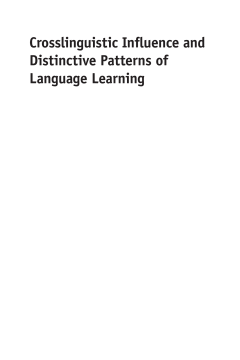
BOOK
Crosslinguistic Influence and Distinctive Patterns of Language Learning
Anne Golden | Dr. Scott Jarvis | Kari Tenfjord
(2017)
Additional Information
Book Details
Abstract
This book details patterns of language use that can be found in the writing of adult immigrant learners of Norwegian as a second language (L2). Each study draws its data from a single corpus of texts written for a proficiency test of L2 Norwegian by learners representing 10 different first language (L1) backgrounds. The participants of the study are immigrants to Norway and the book deals with the varying levels and types of language difficulties faced by such learners from differing backgrounds. The studies examine the learners’ use of Norwegian in relation to the morphological, syntactic, lexical, semantic and pragmatic patterns they produce in their essays. Nearly all the studies in the book rely on analytical methods specifically designed to isolate the effects of the learners’ L1s on their use of L2 Norwegian, and every chapter highlights patterns that distinguish different L1 groups from one another.
Anne Golden is Professor of Norwegian as a Second Language at the University of Oslo, Norway. Her main research is on literacy in a second language, with a focus on vocabulary and in particular metaphors, studying learners’ comprehension, development and practice in and out of school.
Scott Jarvis is Professor of Linguistics at the University of Utah, USA. His areas of research include crosslinguistic influence and lexical diversity. He is the co-editor (with Scott Crossley) of Approaching Language Transfer through Text Classification (2012).
Kari Tenfjord is Professor of Norwegian as a second language at the University of Bergen, Norway. Her research focuses on the development and use of Norwegian as a second language with an emphasis on the acquisition of tense.
This volume is essential reading for anyone interested in the complex problem of language transfer. Especially praiseworthy is the coverage of problems encountered by speakers of highly diverse languages such as Polish, Somali, and Vietnamese in their efforts to acquire Norwegian. The collection also seems exemplary in showing how methods in corpus linguistics can be used to study crosslinguistic influence.
This edited volume brings together findings from the ‘ASKeladden – A corpus-based approach to L1 transfer in Norwegian learner language’ project. It will be of great value to researchers and practitioners interested in how learner corpus data can contribute to the theory and practice of second language acquisition. It is also unique in being grounded in Jarvis’s (2000) methodological framework for the study of transfer.
This excellent collection shows how crosslinguistic influence research can be theoretically interesting and methodologically challenging. The level of mastery is superb, and the result is a strong volume which contains a number of perceptive insights for the reader to reflect upon. A must-read for anyone interested in crosslinguistic influence research, Norwegian and quantitative research methods.
Table of Contents
| Section Title | Page | Action | Price |
|---|---|---|---|
| Contents | v | ||
| Contributors | vii | ||
| Preface | xi | ||
| 1 Introduction | 1 | ||
| 2 Transfer: An Overview with an Expanded Scope | 12 | ||
| 3 The ‘Perfect Candidate’ for Transfer: A Discussion of L1 Influence in L2 Acquisition of Tense-Aspect Morphology | 29 | ||
| 4 On How Polish Learners of Norwegian Render Spatial Prepositions in L2: A Corpus-Based Study of i and på | 64 | ||
| 5 Positive and Negative Transfer in the L2 Adjective Inflection of English-, German- and Polish-speaking Learners of L2 Norwegian | 84 | ||
| 6 Gender Assignment and L1 Transfer in Norwegian Second Language Learners’ Written Performance | 110 | ||
| 7 Stranded or Lost? Preposition Stranding in Norwegian Learner Languages | 155 | ||
| 8 Emotions Negotiated in L2 Texts: A Corpus Study of Written Production by Adult Learners on a Norwegian Test | 188 | ||
| 9 Evaluation of Texts in Tests, or: Where is the Dog Buried? | 231 | ||
| Author Index | 272 | ||
| Subject Index | 277 |
